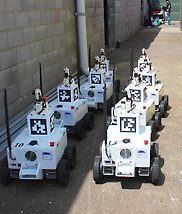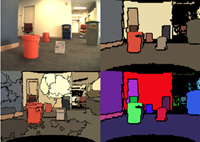Edwin Olson named to Popular Science’s “Brilliant 10” list for 2012

 Enlarge
Enlarge
Professor Edwin Olson has been named one of Popular Science’s “Brilliant 10” for his work in developing an autonomous fleet of intelligent and cooperative robots. The Brilliant 10 are a group of ten researchers under 40 who made transformational contributions to their fields.

 Enlarge
Enlarge

 Enlarge
Enlarge
In 2010, Prof. Olson led the winning team in the Multi Autonomous Ground Robot International Challenge (MAGIC) competition by developing a team of 14 robots that semi-autonomously explored and mapped a large-scale urban environment. Because the robots were able to work as a team, they shared the data that they collected and acted in concert. The actual mechanics of the robots were sturdy and basic, with the enabling technologies found in the robots’ advanced sensor hardware and perception software, and in the artificial intelligence that allowed the robots to collaborate. For winning, the MAGIC competition, the U.S. Department of Defense awarded Prof. Olson $750,000 to continue his research.
Prof. Olson is further developing the technologies that made the MAGIC robots such a success and applying them in new ways. The sensor and perception technology is being built into a system that will automatically determine whether a railroad grade crossing is unsafe. The system builds a 3D model of a grade crossing using LIDAR and camera data, from which it can measure the critical safety parameters of the crossing.
In another project, his research group is making it easier for robots to interpret and navigate a complex interior environment by enabling the creation of a rich 3D data source that combines spatial and color information to simulate the environment. In a third project, Prof. Olson’s team is developing new probabilistic methods that allow pursuers to be more conservative when pursuing smart evaders, and more aggressive when pursuing naive evaders. These techniques will help search and rescue teams to quickly find survivors, sentries to protect against intruders, and law enforcement to apprehend suspects.
Prof. Olson received his PhD in Computer Science from the Massachusetts Institute of Technology in 2008. During his time as a PhD student, he was a core member of their DARPA Urban Challenge Team which finished the race in 4th place. Upon joining the Michigan faculty in 2008, he created the APRIL robotics lab, which studies Autonomy, Perception, Robotics, Interfaces, and Learning. His active research projects include applications for explosive ordinance disposal, search and rescue, railway inspection and safety, and automobile autonomy and safety. He is active in both the open source software community as one of the original developers of the message-passing system LCM, and the creator of the OrcBoard robotics controller. Much of his current software is available under open source licenses. He has taught Introduction to Artificial Intelligence (EECS 492), Autonomous Robotics Laboratory (EECS 498), Mobile Robotics: Methods and Algorithms (EECS 568), and Algorithms for Robots (EECS 598).
Read More:
Popular Science: Brilliant 10 – Edwin Olson Creates An Autonomous Robot Army
U-M Record Update: U-M Robot Team Wins International Competition and $750,000
 MENU
MENU 
